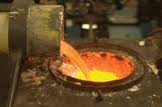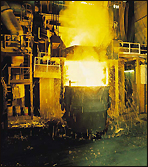A foundry is a factory that produces metal castings. Metals are cast into shapes by melting them into a liquid, pouring the metal in a mold, and removing the mold material or casting after the metal has solidified as it cools. The most common metals processed are aluminum and cast iron. However, other metals, such as, steel, magnesium, copper, tin and zinc, are also used to produce castings in foundries.

Melting is performed in a furnace. Virgin material, external scrap, internal scrap, and alloying elements are used to charge the furnace. Virgin material refers to commercially pure forms of the primary metal used to form a particular alloy. Alloying elements are either pure forms of an alloying element, like electrolytic nickel, or alloys of limited composition, such as ferroalloys or master alloys. External scrap is material from other forming processes such as punching, forging, or machining. Internal scrap consists of the gates, risers, or defective castings.
The process includes melting the charge, refining the melt, adjusting the melt chemistry and tapping into a transport vessel. Refining is done to remove deleterious gases and elements from the molten metal. Material is added during the melting process to bring the final chemistry within a specific range specified by industry and/or internal standards. During the tap, final chemistry adjustments are made.
Several specialised furnaces are used to melt the metal. Furnaces are refractory lined vessels that contain the material to be melted and provide the energy to melt it. Modern furnace types include electric arc furnaces (EAF), induction furnaces, cuploas, reverberatory, and crucible furnaces. Furnace choice is dependent on the alloy system and quantities produced. For ferrous materials, EAFs, cupolas, and induction furnaces are commonly used. Reverberatory and crucible furnaces are common for producing aluminum castings.
Furnace design is a complex process, and the design can be optimized based on multiple factors. Furnaces in foundries can be any size, ranging from mere ounces to hundreds of tons, and they are designed according to the type of metals that are to be melted. Also, furnaces must be designed around the fuel being used to produce the desired temperature. For low temperature melting point alloys, such as zinc or tin, melting furnaces may reach around 327 Celsius. Electricity, propane, or natural gas are usually used for these temperatures. For high melting point alloys such as steel or nickel based alloys, the furnace must be designed for temperatures over 3600 Celsius. The fuel used to reach these high temperatures can be electricity or coke.
The majority of foundries specialize in a particular metal and have furnaces dedicated to these metals. For example, an iron foundry (for cast iron) may use a cuploa, induction furnace, or EAF, while a steel foundry will use an EAF or induction furnace. bronze or brass foundries use crucible furnaces or induction furnaces. Most aluminum foundries use either an electric resistance or gas heated crucible furnaces or reverberatory furnaces.
In the case of aluminium alloys, a degassing step is usually necessary to reduce the amount of hydrogen in the liquid metal. If the hydrogen concentration in the melt is too high, the resulting casting will contain gas porosity that will deteriorate its mechanical properties.
An efficient way of removing hydrogen from the melt is to bubble argon or nitrogen. To do that, several different types of equipment are used by foundries. When the bubbles go up in the melt, they catch the dissolved hydrogen and bring it to the top surface. There are various equipment which measure the amount of hydrogen present in it. Alternetively density of al sample is calculated to check amount of hydrogen dissolved in it.
The final step in the process usually involves grinding, sanding, or machining the component in order to achieve the desired dimensional accuracies, physical shape and surface finish.
Removing the remaining gate material, called a gate stub, is usually done using a grinder or sanding. These processes are used because their material removal rates are slow enough to control the amount of material. These steps are done prior to any final machining.
After grinding, any surfaces that require tight dimensional control are machined. Many castings are machined in CNC milling centers. The reason for this is that these processes have better dimensional capability and repeatability than many casting processes. However, it is not uncommon today for many components to be used without machining.
A few foundries provide other services before shipping components to their customers. Painting components to prevent corrosion and improve visual appeal is common. Some foundries will assemble their castings into complete machines or sub-assemblies. Other foundries weld multiple castings or wrought metals together to form a finished product.
More and more the process of finishing a casting is being achieved using robotic machines which eliminate the need for a human to physically grind or break parting lines, gating material or feeders. The introduction of these machines has reduced injury to workers, costs of consumables whilst also reducing the time necessary to finish a casting. It also eliminates the problem of human error so as to increase repeatability in the quality of grinding. With a change of tooling these machines can finish a wide variety of materials including iron, bronze and aluminum.

At Thermometrics, our guiding objectives are Customer Satisfaction and Continuous Improvement. We accomplish this through monitoring our systems, measuring our performance and employee development. Our goal is to continually work at being the most successful company in the world, in delivering the highest quality of products, technology, competitive pricing, continuous customer service and satisfaction.